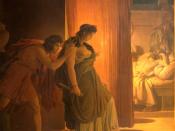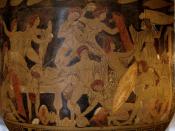In both The Odyssey and Agamemnon the role of women is presented from a patriarchal and misogynist perspective. This is shown in the two main female characters of Penelope and Clytaemnestra. Their situations offer examples of the rewards of fulfilling society's female gender role in the case of Penelope; the consequences of leaving that role are demonstrated by Clytaemnestra. In both stories women are shown as chattel, possessions for distribution to cement political moves, bind families and produce children. Clytaemnestra and Penelope are diametrically opposed representations of women in ancient Greece and as such allow an understanding of the roles of women and how women were viewed by their society.
The Greek ideal of womanhood is seen in those behaviors admired in women. This may be observed through how they are described. It is not possible to give an accurate definition of women's roles in Greek society from two fictional stories written by men.
These will be skewed by the views held by their authors, rather than representative of society's views. However they do offer at least two viewpoints from which to analyze the roles of women in ancient Greece.
Skills play an important role in determining value among women. This is seen when Athena presents herself to Odysseus (Homer, page 239, lines 368-370) '...she seemed a woman,/ tall and beautiful and no doubt skilled/ at weaving splendid things'. Clytaemnestra states how skilled she is at dyeing bronze. Penelope is constantly praised for her weaving, which is used to illustrate her cleverness in one story. Domestic skills are presented as desirable as demonstrated by the reactions of the other characters with whom the women interact.
That women were considered mere possessions is expressed clearly when one of Penelope's suitors suggests what he thinks should happen with her and...


